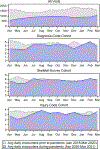Emergency Department Child Abuse Evaluations During COVID-19: A Multicenter Study
- PMID: 35707943
- PMCID: PMC10947367
- DOI: 10.1542/peds.2022-056284
Emergency Department Child Abuse Evaluations During COVID-19: A Multicenter Study
Abstract
Background and objective: The reported impacts of the COVID-19 pandemic on child maltreatment in the United States have been mixed. Encounter trends for child physical abuse within pediatric emergency departments may provide insights. Thus, this study sought to determine the change in the rate of emergency department encounters related to child physical abuse.
Methods: A retrospective study within the Pediatric Emergency Care Applied Research Network Registry. Encounters related to child physical abuse were identified by 3 methods: child physical abuse diagnoses among all ages, age-restricted high-risk injury, or age-restricted skeletal survey completion. The primary outcomes were encounter rates per day and clinical severity before (January 2018-March 2020) and during the COVID-19 pandemic (April 2020-March 2021). Multivariable Poisson regression models were fit to estimate rate ratios with marginal estimation methods.
Results: Encounter rates decreased significantly during the pandemic for 2 of 3 identification methods. In fully adjusted models, encounter rates were reduced by 19% in the diagnosis-code cohort (adjusted rate ratio: 0.81 [99% confidence interval: 0.75-0.88], P <.001), with the greatest reduction among preschool and school-aged children. Encounter rates decreased 10% in the injury cohort (adjusted rate ratio: 0.90 [confidence interval: 0.82-0.98], P = .002). For all 3 methods, rates for lower-severity encounters were significantly reduced whereas higher-severity encounters were not.
Conclusions: Encounter rates for child physical abuse were reduced or unchanged. Reductions were greatest for lower-severity encounters and preschool and school-aged children. This pattern calls for critical assessment to clarify whether pandemic changes led to true reductions versus decreased recognition of child physical abuse.
Copyright © 2022 by the American Academy of Pediatrics.
Conflict of interest statement
Conflict of Interest:
Children’s Hospital of Philadelphia has received payment for the expert testimony of Drs. Chaiyachati and Wood when subpoenaed for cases of suspected abuse.
Figures
Similar articles
-
Counts and child protection reports of diagnosed child maltreatment before and after the COVID-19 pandemic onset.Child Abuse Negl. 2023 Dec;146:106450. doi: 10.1016/j.chiabu.2023.106450. Epub 2023 Sep 13. Child Abuse Negl. 2023. PMID: 37708644 Free PMC article.
-
The Impact of COVID-19 on Infant Maltreatment Emergency Department and Inpatient Medical Encounters.J Pediatr. 2023 Nov;262:113582. doi: 10.1016/j.jpeds.2023.113582. Epub 2023 Jun 22. J Pediatr. 2023. PMID: 37353150 Free PMC article.
-
A comparison of child abuse and neglect encounters before and after school closings due to SARS-Cov-2.Child Abuse Negl. 2021 Aug;118:105132. doi: 10.1016/j.chiabu.2021.105132. Epub 2021 May 24. Child Abuse Negl. 2021. PMID: 34082194 Free PMC article.
-
Trends in U.S. Emergency Department Visits Related to Suspected or Confirmed Child Abuse and Neglect Among Children and Adolescents Aged <18 Years Before and During the COVID-19 Pandemic - United States, January 2019-September 2020.MMWR Morb Mortal Wkly Rep. 2020 Dec 11;69(49):1841-1847. doi: 10.15585/mmwr.mm6949a1. MMWR Morb Mortal Wkly Rep. 2020. PMID: 33301436 Free PMC article.
-
Impact on the incidence of suspected physical abuse in children under 24 months of age during a global pandemic: A multi-centre Irish regional retrospective cross-sectional analysis.Br J Radiol. 2022 Sep 1;95(1137):20220024. doi: 10.1259/bjr.20220024. Epub 2022 Jul 15. Br J Radiol. 2022. PMID: 35786972 Free PMC article. Review.
Cited by
-
COVID-19's causal impact on child abuse and socioeconomic status: a Bayesian time series study.Pediatr Res. 2025 Mar 24. doi: 10.1038/s41390-025-03996-0. Online ahead of print. Pediatr Res. 2025. PMID: 40128593
-
Counts and child protection reports of diagnosed child maltreatment before and after the COVID-19 pandemic onset.Child Abuse Negl. 2023 Dec;146:106450. doi: 10.1016/j.chiabu.2023.106450. Epub 2023 Sep 13. Child Abuse Negl. 2023. PMID: 37708644 Free PMC article.
-
The Impact of COVID-19 on Infant Maltreatment Emergency Department and Inpatient Medical Encounters.J Pediatr. 2023 Nov;262:113582. doi: 10.1016/j.jpeds.2023.113582. Epub 2023 Jun 22. J Pediatr. 2023. PMID: 37353150 Free PMC article.
-
Explanatory capacity of measures of community context for paediatric injury hospitalisations in the USA.Inj Prev. 2025 Jun 26:ip-2024-045423. doi: 10.1136/ip-2024-045423. Online ahead of print. Inj Prev. 2025. PMID: 39819764 Free PMC article.
-
Predictors of Corporal Punishment during the COVID-19 Pandemic.Pediatr Rep. 2024 Apr 19;16(2):300-312. doi: 10.3390/pediatric16020026. Pediatr Rep. 2024. PMID: 38651465 Free PMC article.
References
-
- Sidebotham P, Golding J, The ALSPAC Study Team, Children. Child maltreatment in the “children of the nineties” a longitudinal study of parental risk factors. Child Abuse Negl. 2001;25(9):1177–1200. - PubMed
-
- Dubowitz H, Kim J, Black MM, Weisbart C, Semiatin J, Magder LS. Identifying children at high risk for a child maltreatment report. Child Abuse Negl. 2011;35(2):96–104. - PubMed
-
- Berger RP, Fromkin JB, Stutz H, et al. Abusive head trauma during a time of increased unemployment: a multicenter analysis. Pediatrics. 2011;128(4):637–643. - PubMed
-
- Huang MI, O’Riordan MA, Fitzenrider E, McDavid L, Cohen AR, Robinson S. Increased incidence of nonaccidental head trauma in infants associated with the economic recession. J Neurosurg Pediatr. 2011;8(2):171–176. - PubMed
Publication types
MeSH terms
Grants and funding
LinkOut - more resources
Full Text Sources
Medical
Miscellaneous



